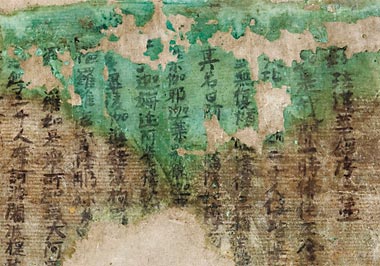The next work, introduced here, is a tattered sutra that was buried many long years ago. The paper is damaged in places, and its upper portion has discolored and turned green from the patina of its bronze cylindrical case that bled onto it causing a somewhat decorative effect.
Moreover, the handwriting is quite poor. The characters of the first line across are somewhat difficult to read but the remaining part of the title, Hōrengekyō, indicates that it is a copy of the Lotus Sutra—the illegible first character being myō (“wondrous”). One may almost marvel at how its copyist could have possibly produced all eight scrolls of this scripture. However, it can also be seen that he tried very hard and worked diligently to write many difficult characters with numerous strokes onto several meters of paper. Still more, writing with a brush requires great skill.
Perhaps our copyist wished to hear directly the teachings of the Buddha and imagined scenes of the Buddha giving sermons to people on Vulture Peak, which can be found throughout the Lotus Sutra. He says to himself, “Then, the Future Buddha, Maitreya (J., Miroku), may appear, and when he does, I hope to be reborn there.”
The copyist sees the future, and a vision of Maitreya, filled with beauty and wisdom, holding the sutra he so diligently copied, appears before his eyes. Maitreya asks him who had written out this sutra. Trembling with humility, the scribe answers to the smiling Buddha that he had done so. Maitreya then invites him to his side under the Dragon Flower Tree, where tens of thousands of followers are already gathered to hear the sermon of the Future Buddha. Everyone there appears radiant and ready to attain enlightenment. The copyist joins the audience and awaits Maitreya to expound his teachings. This vision revives the tired copyist and encourages him to again pick up his brush to copy the sutra. Though unskillful, he writes out letter by letter with great care.
Could it be that several hundred years later, his wish has been granted? Today, his sutra, dyed with a blue-green patina, beautifully recounts his spirituality. Please visit the museum to see these expressions of faith and enjoy the Tales of Buddhas.

Japan, Heian period, 12th century, MIHO MUSEUM
(Exhibited from 7/11 to 8/16)